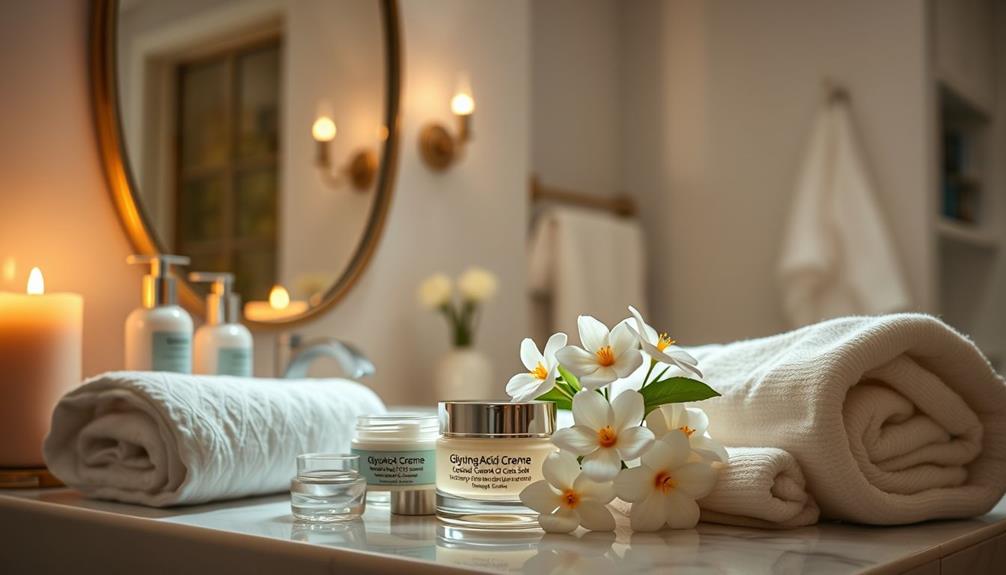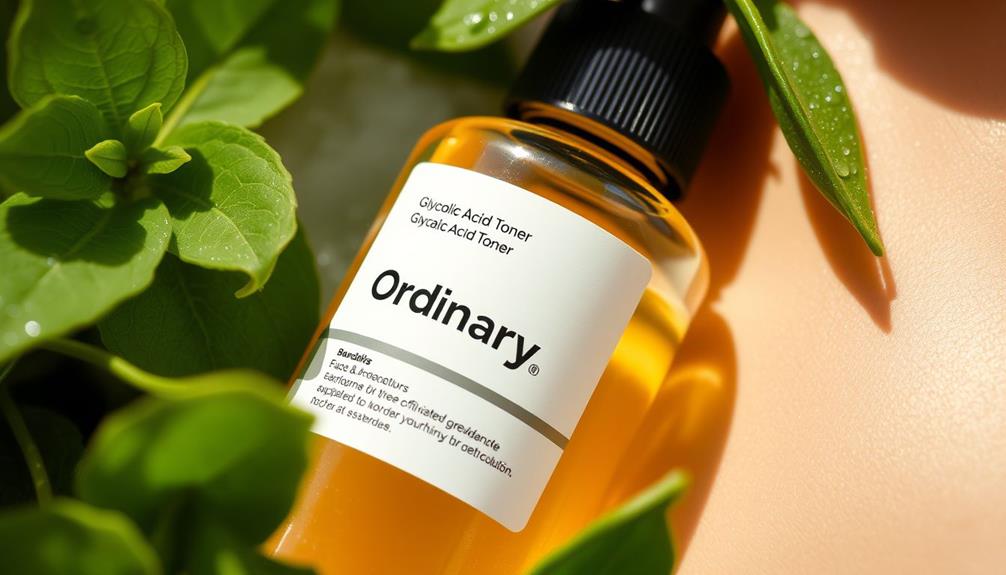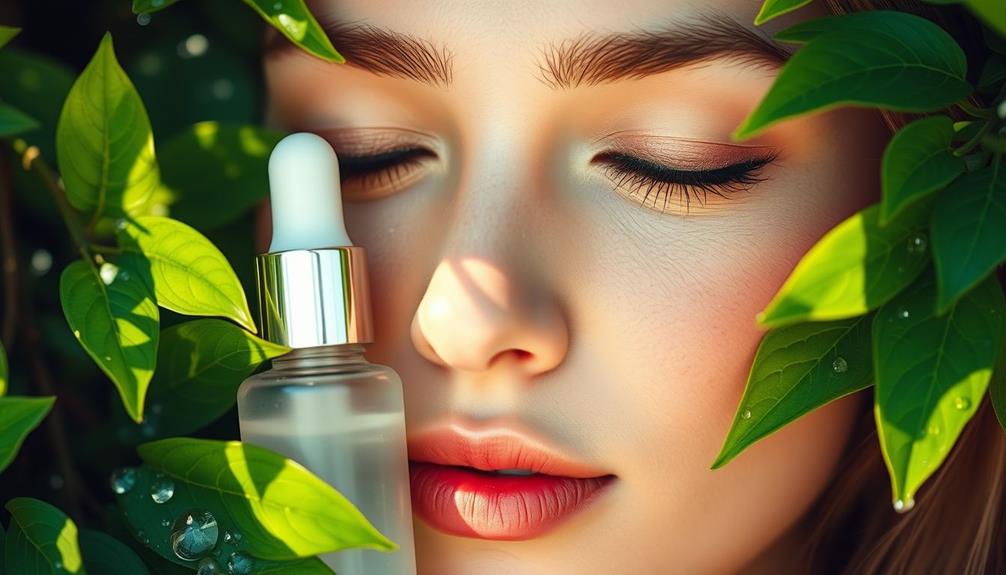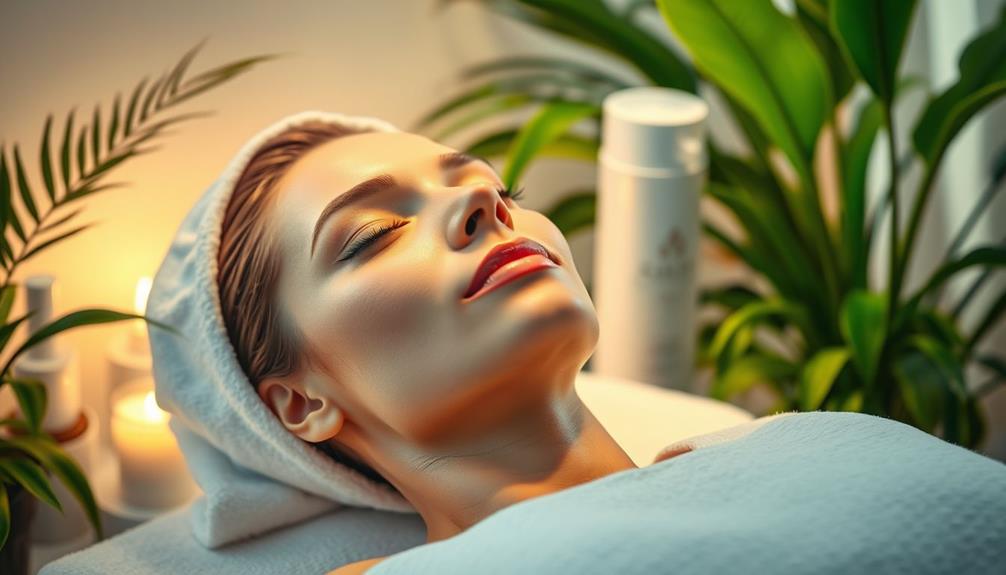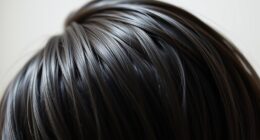Glycolic acid, derived from sugarcane, is a powerful alpha hydroxy acid that works wonders for your skin. It gently exfoliates dead skin cells, enhancing your skin's texture and promoting a radiant glow. By penetrating deeply, it stimulates collagen production, improving firmness and elasticity while unclogging pores and reducing acne. This acid also boosts moisture retention, helping your skin stay hydrated and youthful. Regular use can diminish fine lines and dark spots, giving you a clearer complexion. Interested in how to incorporate it into your routine for maximum benefit? You'll find more insights ahead!
Key Takeaways
- Glycolic acid is a powerful alpha hydroxy acid (AHA) that exfoliates the skin by dissolving bonds between dead skin cells, enhancing texture.
- It stimulates collagen production, improving skin firmness and elasticity while reducing fine lines, wrinkles, and uneven skin tone.
- Glycolic acid acts as a humectant, attracting moisture to skin cells and strengthening the skin barrier for better hydration.
- Regular use promotes faster cell turnover, aiding in the treatment of acne, dark spots, and signs of photoaging.
Understanding Glycolic Acid
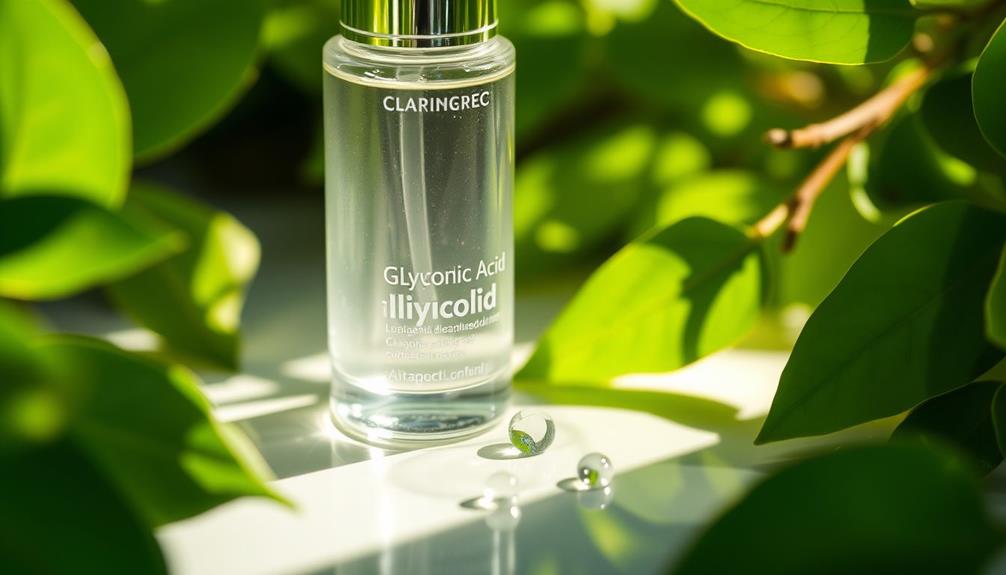
Glycolic acid is a powerful alpha hydroxy acid (AHA) derived from sugarcane, known for its ability to deeply penetrate your skin and effectively promote cell turnover.
As a chemical exfoliant, it works by dissolving the bonds between dead skin cells, revealing a smoother and more radiant complexion. This exfoliation not only enhances your skin's texture but also paves the way for other active ingredients in your skincare products to penetrate better.
Additionally, incorporating natural ingredients like essential oils can further enhance your skincare routine, providing essential oils for relaxation or other benefits.
One of the standout benefits of glycolic acid is its role in collagen production. By stimulating collagen synthesis, it helps improve skin firmness and elasticity, reducing fine lines and wrinkles.
If you're struggling with acne, glycolic acid can be a game changer. It aids in acne treatment by unclogging pores and reducing inflammation, leading to clearer skin.
Additionally, glycolic acid effectively tackles hypopigmentation, helping to fade dark spots and even out your skin tone.
You'll find glycolic acid in various skincare products, from serums to creams and peels, typically available in concentrations ranging from 5% to 70%.
This versatility makes it an essential ingredient in achieving healthier, more youthful-looking skin.
Mechanism of Action
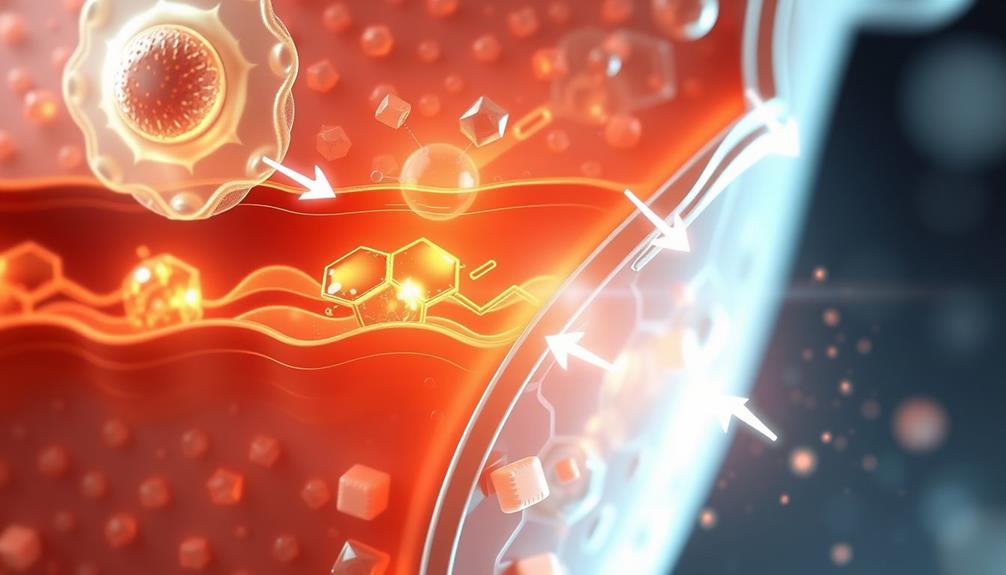
Glycolic acid's chemical exfoliation process sets it apart from other ingredients.
With its small molecular size, it penetrates your skin effectively, breaking down the bonds between dead skin cells.
This action not only promotes cell turnover but also helps improve your skin's overall texture and appearance.
Incorporating regular physical activity into your skincare routine can enhance the benefits of glycolic acid, as stress management techniques further support your skin's health.
Chemical Exfoliation Process
As an alpha hydroxy acid (AHA), glycolic acid effectively breaks down the bonds between dead skin cells, making it easier for them to be exfoliated and revealing fresher skin underneath. This chemical exfoliation process accelerates cell turnover, which not only helps improve skin texture but also enhances radiance.
By promoting regular shedding of dead cells, glycolic acid plays an essential role in the formulation of many anti-aging products. Additionally, the regular use of exfoliating agents can lead to better absorption of other skincare products, allowing them to penetrate deeper into the skin and work more effectively.
Moreover, as you incorporate glycolic acid into your skincare routine, you're likely to notice a reduction in the appearance of dark spots and hyperpigmentation. This happens because glycolic acid encourages faster cell turnover, allowing newer, healthier skin to surface more quickly.
Additionally, the exfoliation process stimulates collagen production, which can help firm your skin and improve its elasticity over time.
Regular use of glycolic acid can lead to significant improvements in the overall look and feel of your skin. With continued application, fine lines and wrinkles may become less visible, giving you a more youthful appearance.
This makes glycolic acid a powerful ingredient in your skincare arsenal for achieving smoother, healthier skin.
emotional attachment in cats might help you understand how regular routines can also benefit your pet’s well-being.
Skin Penetration Ability
The small molecular structure of glycolic acid allows it to penetrate deeply into the skin, making it particularly effective in enhancing overall skin health and appearance. As the smallest of the alpha hydroxy acids (AHAs), glycolic acid excels at promoting skin penetration and facilitating exfoliation. By dissolving the bonds between dead skin cells, it accelerates cell turnover, revealing a fresher complexion beneath.
Additionally, the use of essential oils in conjunction with glycolic acid may provide complementary benefits, such as enhanced hydration and soothing effects, which can be explored in aromatherapy techniques.
Moreover, glycolic acid influences keratinocyte activity, which is essential for boosting ceramide synthesis. This improvement enhances the skin barrier function, helping your skin retain moisture and stay hydrated. As a result, you'll notice a more resilient and supple texture over time.
Additionally, the exfoliation process stimulated by glycolic acid encourages collagen production, leading to firmer, more elastic skin. Its ability to penetrate deeply also enhances the effectiveness of other topical treatments, making it a valuable ingredient in combination therapies.
Benefits for Skin

Glycolic acid offers a range of benefits for your skin, starting with its powerful exfoliation and renewal properties.
You'll notice improved hydration and moisture retention, leaving your skin feeling refreshed and plump.
Additionally, it can enhance firmness and reduce signs of aging, making it a key player in your skincare routine.
Exfoliation and Skin Renewal
Releasing radiant skin, glycolic acid effectively exfoliates by breaking down the bonds between dead skin cells, revealing a smoother and more youthful complexion.
This powerful alpha-hydroxy acid promotes skin renewal by enhancing cell turnover, which can diminish fine lines, wrinkles, and uneven skin tone. Regular use of glycolic acid, whether through daily products or chemical peels, stimulates collagen production, boosting your skin's elasticity.
If you're dealing with acne, glycolic acid can be a game-changer. It unclogs pores and reduces the buildup of dead skin cells, making it particularly beneficial for oily and acne-prone skin types. As you incorporate glycolic acid into your routine, you'll notice improved skin texture and clarity.
Moreover, the exfoliation process helps your skin better absorb other products, ensuring they work more effectively. While glycolic acid is also a humectant, attracting moisture to the skin, its primary focus here is on the transformative effects of exfoliation and skin renewal.
Hydration and Moisture Retention
When it comes to hydration and moisture retention, glycolic acid stands out as a powerful ally that attracts and binds water to your skin cells. This humectant not only enhances hydration levels but also plays an essential role in improving your skin texture and overall appearance. By promoting skin cell turnover, glycolic acid effectively removes dead skin cells, allowing healthier skin to thrive beneath.
Here are some key benefits of glycolic acid for hydration and moisture retention:
- Enhanced hydration: It draws moisture into the skin, keeping it plump and dewy.
- Improved skin texture: Regular use leads to a smoother, more refined surface.
- Better moisture retention: By strengthening the skin barrier, it helps lock in hydration.
- Increased collagen production: Supports overall skin health and elasticity.
Incorporating glycolic acid into your skincare regimen can greatly improve your skin's hydration levels and moisture retention, giving you a healthier, more vibrant complexion.
Anti-Aging and Firmness Benefits
Harnessing the power of glycolic acid can greatly boost skin firmness and combat the signs of aging, giving you a smoother, more youthful complexion.
This alpha hydroxy acid (AHA) is renowned for its anti-aging benefits, primarily due to its ability to enhance collagen production. By promoting collagen synthesis, glycolic acid helps improve skin elasticity, effectively reducing the appearance of fine lines and wrinkles.
Regularly using glycolic acid exfoliates the outer layer of dead skin cells, revealing fresher, healthier skin underneath. This process not only enhances skin texture but also contributes to overall skin rejuvenation.
Clinical studies show that it can considerably improve skin tone and diminish dark spots, leading to a more radiant, youthful appearance.
Additionally, glycolic acid's hydrating properties help prevent moisture loss, maintaining that plump look you desire.
With consistent use, you'll notice a remarkable transformation in your skin's firmness and texture, making it an essential ingredient in your anti-aging skincare routine.
Embrace glycolic acid and uncover the secret to revitalized, youthful skin!
Applications in Cosmetic Treatments
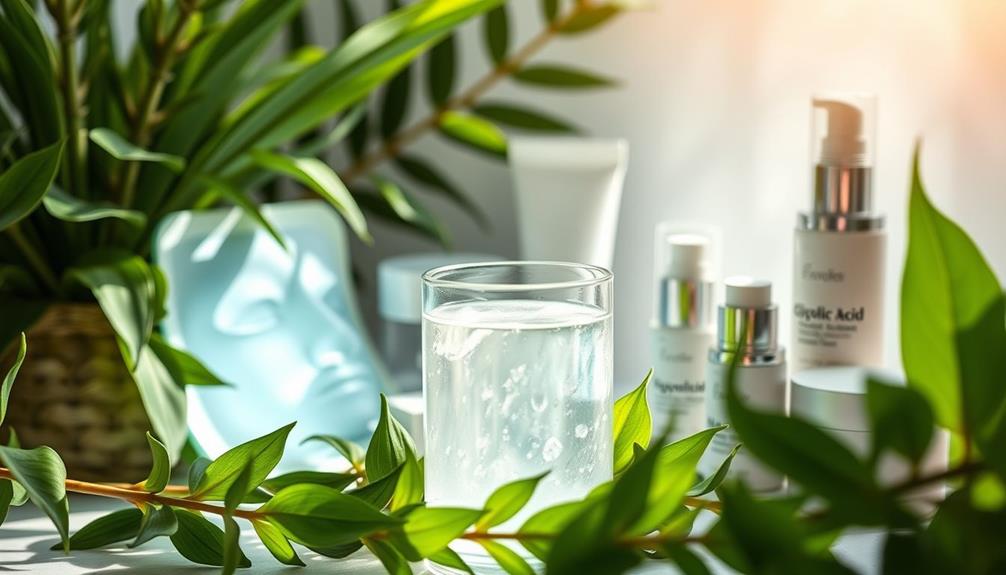
Glycolic acid plays an essential role in cosmetic treatments, effectively exfoliating the skin to reveal a smoother, more radiant complexion. As an alpha hydroxy acid (AHA), it dissolves the bonds between dead skin cells, making it a popular choice for various applications.
Here's how glycolic acid benefits your skin:
- Chemical Peels: High concentrations (20% to 70%) are used in professional peels for instant rejuvenation.
- Melasma Treatment: While results can vary, combined with agents like hydroquinone, it can enhance overall skin lightening.
- Improving Skin Texture: Regular use refines the skin's surface, reducing roughness and unevenness.
- Addressing Photoaging: It helps diminish signs of aging like fine lines and sun damage, promoting a youthful appearance.
Incorporating glycolic acid into your skincare routine can lead to noticeable improvements in skin texture and resilience against issues like acne and photoaging. Embrace its exfoliating properties for a vibrant, youthful glow!
Safety and Side Effects

While glycolic acid offers numerous benefits for skin health, it's important to be aware of its safety and potential side effects.
When using glycolic acid topically, especially in concentrations above 10%, you may experience side effects like redness, stinging, and peeling. These reactions are more common if you have sensitive skin or are using higher concentrations of the acid.
If you're prone to skin irritation or contact dermatitis, be cautious and monitor your skin's response during use. Conducting a patch test before full application is a smart move to identify any adverse reactions early on.
Additionally, glycolic acid can increase your skin's sensitivity to UV radiation, making it essential to apply sunscreen daily while undergoing treatment. This will help protect your skin from potential damage.
Always consult healthcare professionals for personalized medical information regarding your skin type and the appropriate use of glycolic acid. By being informed and cautious, you can enjoy the benefits of glycolic acid while minimizing risks.
Guidelines for Use

To get the most out of glycolic acid, start with lower concentrations and gradually build up as your skin adjusts. Here are some guidelines to follow when using glycolic acid:
- Begin with a concentration of 5-10% to assess skin tolerance, especially if you have sensitive skin.
- Always conduct a patch test on a small area before applying glycolic acid to check for adverse reactions.
- Apply glycolic acid topical products at night to reduce sun sensitivity, and use sunscreen during the day.
- Use these products consistently, typically once or twice daily, for up to 4 months, adjusting based on your skin's response.
Comparative Efficacy With Other Treatments
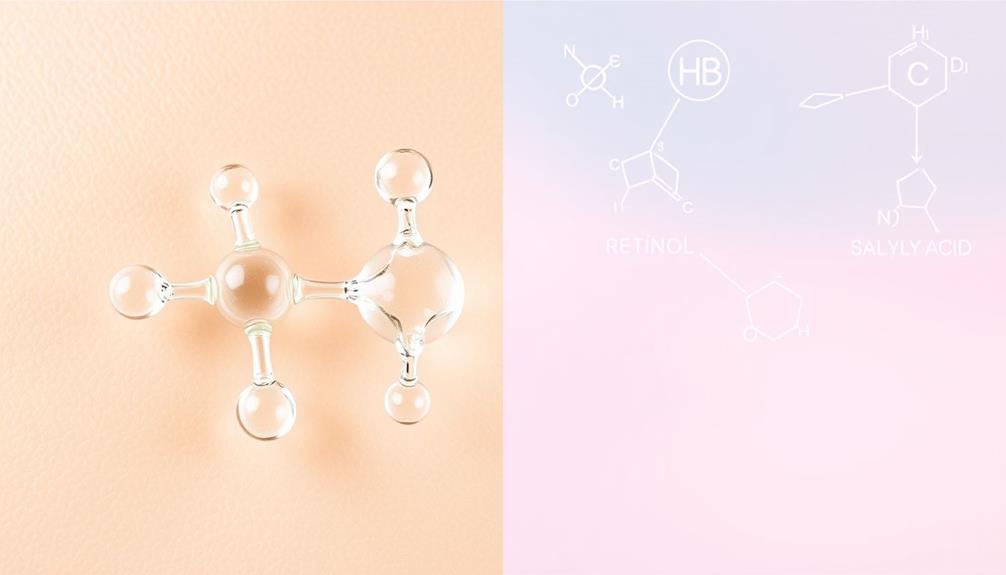
When considering treatment options, glycolic acid stands out for its comparable efficacy to other popular skincare treatments, making it a versatile choice for various skin concerns.
In melasma treatment, for instance, glycolic acid peeling has shown similar results to trichloroacetic acid (TCA) peels but with quicker response times and less irritation.
Moreover, a study highlighted that 20% glycolic acid can effectively manage conditions like molluscum contagiosum, showcasing its versatility alongside treatments like 30% salicylic acid.
For those dealing with atropic acne scars, combining 70% glycolic acid peels with microneedling considerably enhances treatment outcomes compared to microneedling alone.
Topical formulations featuring 8% glycolic acid and 8% L-lactic acid have also proven effective in improving photodamaged skin, underscoring glycolic acid's role in anti-aging solutions.
Additionally, combination therapy utilizing 5% tranexamic acid with 30% glycolic acid peels accelerates melasma improvement, highlighting the benefits of integrating glycolic acid into your skincare regimen.
This evidence illustrates that glycolic acid isn't just effective on its own but can also enhance the efficacy of other treatments.
Innovations in Glycolic Acid Research
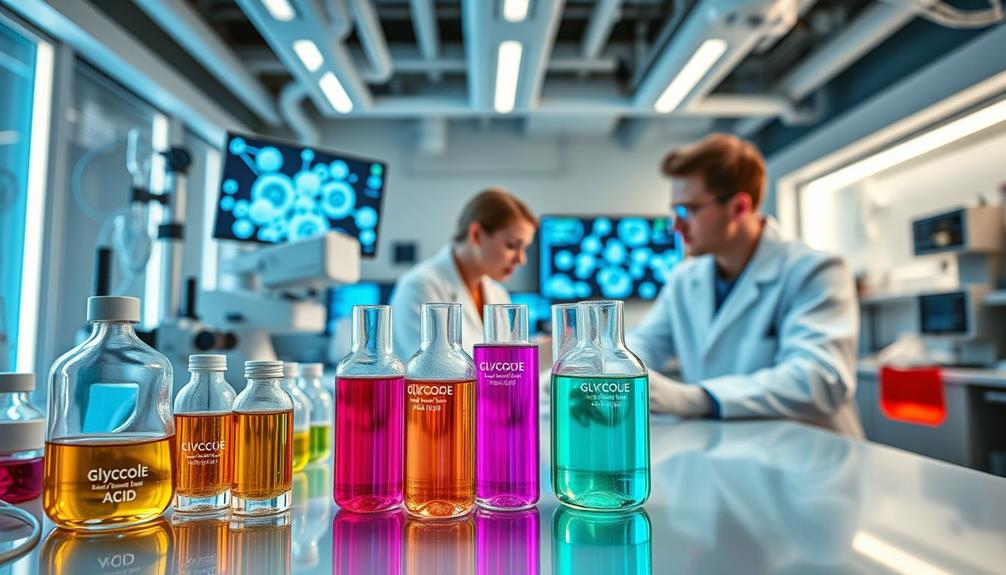
Recent advancements in glycolic acid research reveal its growing potential in combination therapies and innovative formulations that enhance skin texture and rejuvenation.
You'll be excited to know that recent studies highlight how effectively glycolic acid works alongside other agents, particularly in the area of anti-aging treatments and chemical treatments.
- Glycolic acid paired with tranexamic acid accelerates melasma improvement.
- New formulations cater to various skin types, enhancing appearance through tailored treatments.
- It not only exfoliates but also stimulates collagen production, boosting skin elasticity.
- Clinical trials show glycolic acid peels yield results comparable to TCA peels but with faster response times.
These innovations emphasize glycolic acid's versatility in skin care products, making it an essential ingredient for anyone looking to improve their skin texture and achieve a youthful glow.
As you explore your options, consider how these advancements can be integrated into your skincare routine for best results.
Conclusion
So, you've learned about glycolic acid, the magical potion that promises youthful skin with minimal effort.
Who needs sunscreen when you can just slather on this wonder?
But remember, while you're chasing that perfect glow, your skin's not just a canvas; it's a living, breathing entity.
Treat it right, or you might just end up with a science experiment gone wrong.
So, embrace the science, but don't forget to listen to your skin—it's got a voice too!

